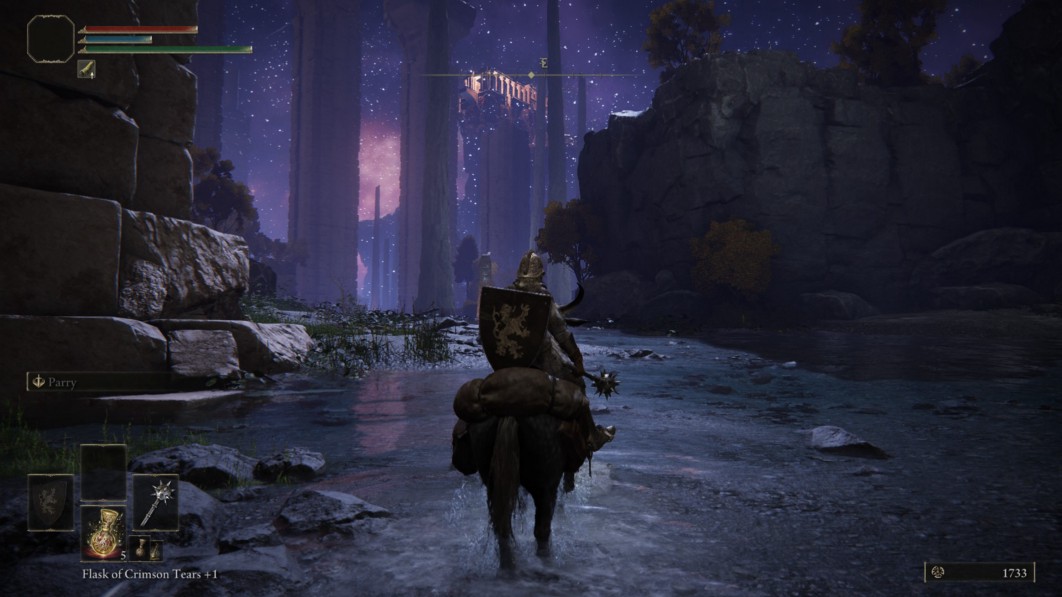
Featured Blog | This community-written post highlights the best of what the game industry has to offer. Read more like it on the Game Developer Blogs or learn how to Submit Your Own Blog Post
How Elden Ring Succeeds by Ignoring 20 Years of Open-World Design
Elden Ring is the current hot topic and for today's piece, I wanted to talk about how From Software made an excellent open-world game, by ignoring the conventional trends of the genre.

If you’re one of the few people who missed the news, Elden Ring, the latest game by From Software is now out. My massive review for it should be out after this piece, but spoiler alert: the game has gotten high praise all around. In an interesting turn, there are developers throwing shade at the game and saying that it did well because of “bad UX” or “horrible controls.” For today’s post, we’re going to dissect why Elden Ring is resonating with so many people, and it did that by ignoring every convention of open-world design over the last 20 years.
Upen World
When anyone thinks about open-world design today, they will most likely think of a game from Ubisoft, or one similarly designed. I’ve joked about how I don’t like this style of open-world, or “Upen World” design before, but what does it mean?
Open-world design for a lot of games is about a very macro experience: with tons of McGuffins, side quests, and “things” to do. The games typically have several side quests types that are repeated and again in each area of the game. One of the most famous is having to climb a tower or high structure to unlock the map for an area and get the entire list of chores to do there.
When it comes to the actual moment-to-moment gameplay, these titles are often very thin. Combat will often play out the same way, and the mechanics at this level are kept basic so that the player can focus on the objectives and bonus stuff. Around the time of Elden Ring’s launch, the other big-name game at the time was Dying Light 2 which boasted hundreds of hours of things to do in the world. And then after that came Horizon: Forbidden West. Incidentally, both games I had no interest in playing due to them being open-world games.

many open world games are less about the world itself, and more about the “things” the developer wants you to do
There is this sense that you’re not exploring a world but going on an amusement ride with everything curated to you. You can really get that feeling out of the trailers for Far Cry 6. You can only go where the game tells you to go, things only really happen on missions, and the world feels very barren to go around. Many open-world games are 1:1 based around the power fantasy trope and how you are going to save the world and be the hero. The first thing that Elden Ring does is exemplify one of the major themes of the Souls games.
You Don’t Matter
In most stories, the world needs a hero, someone who is going to go out there and save the princess, beat the bad guy, and bring happiness and sunshine back by the end of the game. You know, as the player, that the game isn’t going to end with you failing or the bad guy winning.
In the world of Soulsborne however, you’re not the hero and the world can’t be saved. A major theme of these games is that the world is for all intents and purposes broken beyond repair. Anyone who could have saved things is either dead or corrupted. Even the villains have long since won and are nothing more than husks with no other purpose. At best, all you can do is restart the cycle for the inevitable next collapse of the world centuries later. I’ve said before that while the souls games are often poor when it comes to storytelling, they are amazing when it comes to environmental design and lore.

the world of elden ring is vast, detailed, and does not care about you at all
There is this somber realization that happens as you wander through the streets and countryside of these games that a whole lot has happened here a long time ago, and you’re just a visitor to a dead world. Elden Ring continues this style but in a far larger space. Towns have long since been abandoned or destroyed, no one is really interested in saving the day, and you are given complete freedom to go on the most horrific walking tour of the land.
Letting the Player Breathe
From Software has become masters at getting out of the player’s way and letting the player absorb what is happening around them. The adage “less is more” can be applied here and sits in stark contrast to other open-world games.
It is common to be bombarded with things to do, UI tooltips to read, and constantly going to the various submenus to see what to do next. This is by far the largest game space that From Software has done to date, while still providing their trademark level design.
Unlike other open-world games, there are far fewer diversions to do, but the quality of each point of interest is far higher. The game splits its content between small areas with a single reward like the ruins, larger areas to gather resources like the mines and tombs, and the larger set pieces that feel like a traditional level in a previous soulsborne. Instead of just a constant drip-feed of content, the game makes the player want to go out and explore. If there’s something unusual in the distance, chances are there is going to be a unique situation waiting for you.
There are people who say that Elden Ring is proof that people don’t want good UI/UX (user interface, user experience), but they’re not understanding how much good pacing can be a teacher unto itself.
Organic Learning
For the clearest distinction between Elden Ring and other open-world games, you can look at the differences between their openings. In other open-world games, the player is treated to a required and scripted tutorial sequence, constant popups as to what everything does, and all this with high octane excitement. In Elden Ring, you can literally skip the entire tutorial, sometimes by accident if you want. The game purposely features a very simplified opening that passively introduces the open world, the grace points, and like other soulsborne games, doesn’t immediately unlock leveling up.

there is very little that is actually locked to an Elden Ring player at the start
The player is given time to focus on the immediate play without the game trying to stop them from doing so. If we’re being generous, the only real forced interaction you need at the start is getting Torrent, and that can take about 10 minutes if you rush.
Out of all the previous soulslikes, Elden Ring is the fairest in terms of providing options and routes. If you want to rush through the castle and beat Godrick right at the start, you can do that. If you want to spend 6 or more hours exploring the world around the castle, that’s fair as well. A subtle aspect of Elden Ring’s progression is that outside of getting new spells, you’re not really spiking in terms of power. Upgrading your weapons will provide you with more damage, but if you can’t easily fight a boss with a +3 weapon, then a +7 is not going to help you that much. Gear, like Bloodborne is nice, but at the end of the day, it’s more about your stats and skill vs. whatever armor you’re wearing outside of the heaviest or lightest.
There’s Always a Plan B
For a lot of open-world games, there is this sense that the world isn’t as open as the box implies. Areas are often sectioned off based on plot, missions have strict linearity as to what you can do, and the abilities or level of a character will often be a hard gate towards doing something. With exception to the happy area known as Caelid, enemy strength and challenges are kept consistent. If someone is the same size as the player, they should be easy enough to deal with, larger enemies, a bit harder.
What’s often the frustrating point in previous games is that progress is linear. If the player gets stuck at X, there is no other way to go or progress to be made elsewhere. This is often why the skill curve in Soulsborne titles are so high at the start — if the player can master the beginning, then there aren’t going to be challenges that much higher.

there are more options than never for beating the different bosses
With Elden Ring, the bosses and general enemies are harder than their contemporaries in previous games. There are more enemies, they have more advanced combo patterns, and are across the board more dangerous. With that said, why aren’t more people complaining about the increased difficulty? The reason is that with exception to the late-game challenges and final areas, the player for most of the early and mid-game is not forced to go somewhere to make progress. In my first play, it took about 6 and a half hours of exploring and finding items before I beat Margit. On my second character, I did it in an hour and a half.
The free-form nature also applies to your combat tactics. You may use spells, summon NPCs, go for your ash summons, use craftables, collect craftables and never make them (like me), and so on. It is very easy to gauge whether you have any chance in a situation, and the player is free to decide how far they want to try and punch up.
Learning to Cut Loose
What are the takeaways from all this? Is Elden Ring perfect? I would say no, and there are some general issues with the game that I’ll talk about more in my review. From an open-world perspective, the game does a brilliant job of laying out this world to explore and inviting the player to go as far as they want. Instead of the game telling the player to do X, it lets them create their own route through it. The player is the one who creates the mental map as to the rules and discoveries. It’s still too early to tell, but I’m going to be curious to see where the churn rates eventually settle on the game in about a year or so.

Fight or flight is very real in this game
When it comes to open-world games, I’ve never liked the “fakeness” of the open-world and why games like Skyrim, Horizon, the Assassin’s Creeds, and so on, didn’t interest me. Too many open-world games focus on macro gameplay, whereas Elden Ring builds its open-world from its moment-to-moment gameplay. For a lot of open-world games, the “world” itself feels secondary to the challenges and hoops the designers want the player to jump through. Here, this feels like a world that has existed for some time, and all the exploration and challenges are organic to the setting itself. The player doesn’t know where they’re going or what they’re going to find, but they know they’re going to be in for a challenge no matter what.
Elden Ring exudes confidence in its design that basically rewrites the entire book on Soulslike and open-world design, and I’m sure there will be more to talk about as I continue my one-man, one jellyfish, one jumping horse, trek through it.
If you enjoyed this story, consider joining the Game-Wisdom Discord channel. It’s open to everyone.
Read more about:
Featured BlogsAbout the Author(s)
You May Also Like







.jpeg?width=700&auto=webp&quality=80&disable=upscale)








